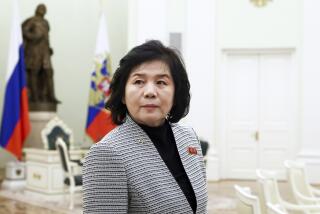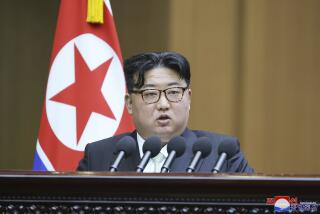South Korea’s President Moon heads for Washington to help keep Kim and Trump summit alive

Three weeks ago, South Korean President Moon Jae-in triumphantly celebrated a successful inter-Korean summit — a precursor, it seemed, for a historic sit-down between North Korean leader Kim Jong Un and President Trump.
Now the summit between Kim and Trump scheduled for June 12 in Singapore at times seems in doubt. The North issued threats last week that it might drop out after objecting to recent military drills by South Korea and the U.S. and the possibility that Washington would take a hardline stance on its denuclearization.
Moon, the son of North Korean war refugees who has staked his political legacy on trying to end the decades-old stalemate between the North and South, is traveling to Washington this week with the goal of keeping the Kim-Trump summit alive.
“His job is to connect the rails between Washington and Pyongyang, as relations have clearly gotten off track,” said Christine Ahn, the founder of Women Cross DMZ, a group that seeks inter-Korean peace.
Moon is expected to visit Trump at the White House on Tuesday, his third formal summit with the U.S. president. The two have also talked by phone several times this year.
Analysts said Moon’s efforts are expected to focus on the goal of keeping talks between the North and the U.S. possible — and ultimately successful — while looking out for South Korea’s well-being. The South’s security is linked to peace between the U.S. and North Korea.
In addition to sharing international concerns about the use of nuclear weapons by the North, the South feels the sustained threat of conventional weapons such as artillery by its neighbor. The U.S. is a key ally with 28,000 troops in the South, but the two countries have had thorny disagreements over security costs and trade policy.
Moon will naturally want to “avoid any agreement that undermines South Korean interests,” said Timothy Rich, an associate professor of political science at Western Kentucky University whose work focuses on East Asia.
The momentum for the summit between Trump and Kim seemed strong after two visits to Pyongyang by Secretary of State Mike Pompeo and the release this month by the North of three U.S. prisoners.
The North, whose third-generation dynastic leader showed an amiable side during the summit last month with Moon, had seemed willing — to the surprise of many observers — to discuss its nuclear program.
But the North, long an unpredictable negotiator, raised concerns about joint U.S.-South Korean military exercises. The North has historically complained about such drills, which the United States says are defensive, but had not raised concerns during a flurry of apparent diplomatic progress in recent weeks.
One key test regarding whether the summit will happen will be whether the North continues dismantling its main nuclear test site at Punggye-ri, as promised, this week. It has invited a handful of international journalists to witness the event.
The Trump-Kim talks, which would be the first between a sitting U.S. president and a North Korean leader, were expected to allow discussion of the nation’s nuclear weapons and ballistic missile programs. Its weapons advancement prompted international condemnation and economic sanctions last year.
But North Koreans threatened to back out of the summit when John Bolton, the national security advisor, suggested Pyongyang abandon nuclear weapons efforts in exchange for economic benefits, as Libya did years ago. In that case, leader Moammar Kadafi ultimately died at the hands of Western-backed rebels.
Trump later said that the Libya model did not apply and that if a deal were reached Kim would be running North Korea.
Despite the uncertainty ahead, the summit probably wouldn’t be possible without a confluence of factors — including, some analysts said, Moon’s stubborn focus on keeping dialogue with the nuclear-armed nation a possibility in the face of adversity during his first year in office.
Last summer, the democratically elected South Korean leader took the risky step of inviting the North to the Winter Olympics, which were held in February.
North Korea’s representative on the International Olympic Committee, Chang Ung, almost immediately rejected the offer: “The Olympics should not be used for a political aim,” he said then.
Then, on July 4, Kim’s government launched its first intercontinental ballistic missile — a scientific breakthrough that stunned the international community.
The test, and others after, promised to halt the progressive Moon’s goal of reconciliation with the North, which has remained separated under an uneasy cease-fire agreement after the Korean War.
The United States and the North, at times, seemed on the brink of armed conflict, yet Moon kept talking to his country — and Trump — about peace.
Eventually, after declaring itself a modern nuclear state, the North agreed to join the Games, marching in with the South under a neutral unification flag and participating in a combined women’s hockey team.
Moon endured some political damage over his efforts to include the North in the Games, though his domestic approval rating is now about 80%. Observers say he remained focused, and the sporting events led to more dialogue and ultimately the summit at Panmunjom — the diplomatic outpost on the border — last month.
Moon and Kim, who greeted one another warmly in a remarkable display given the nations’ history, agreed upon a three-page declaration that set a framework for improved Korean relations, a potential peace treaty and the “common goal” of denuclearization.
The South Korean president has also stood by Trump along the way, insisting that the North entertain the idea of relinquishing its weapons before the South might back concessions, such as easing sanctions.
Moon has also shown a willingness to offer credit to Trump, despite some ambivalence about the American president among the public in South Korea.
“Moon is flattering the president to keep Trump tied to a diplomatic track and prevent a reversion to last year’s war threats,” said Robert Kelly, a political science professor at Pusan University who blogs about regional security issues.
Scott Snyder, a senior fellow for Korea studies and director of the program on U.S.-Korea policy at the Council on Foreign Relations, said he has wondered which of the three leaders was willing to make the biggest bet for change.
“It’s like watching a poker game,” Snyder said, “and to my surprise, I’ve come to the conclusion that Moon is the one who took the greatest risk.”
Stiles is a special correspondent.
More to Read
Start your day right
Sign up for Essential California for news, features and recommendations from the L.A. Times and beyond in your inbox six days a week.
You may occasionally receive promotional content from the Los Angeles Times.







